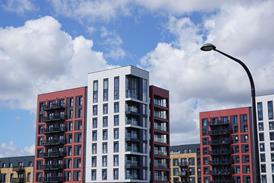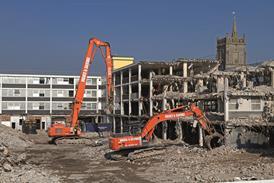Localised crises in the quality and availability of site skills have combined with unbudgetable delays in every step of the planning process to spook the industry in its most profitable year since the 1980s. Add those problems to a hostile political landscape and you have management challenges collectively as draining as a market crash. Institutionalised Nimbyism. Political isolation: if there was the odd sympathetic ear among Tony Blair's Cabinet, HM's Opposition playing residential development as its joker card has probably plugged it. Some must be wishing the Millennium Bug could put the political clock back.
Then, of course, there is the consumer agenda. Where Sir John Egan calls for fewer defects, consumers are screaming and stamping their feet for none. The industry is shocked by how relations with customers so often end in hostilities. But TV's regular dressing-down of the new-build industry has conditioned many buyers into a state of permanent anxiety, every commonplace defect rousing preprogrammed mistrust, often leading to implacable customer angst.
Mick Noble, New Homes Marketing Board chairman and managing director of Peterborough-based Stamford Homes believes the consumer confidence gap is a defining challenge. "The one thing that will turn this situation around is when we start winning the hearts and minds of the public with service they'll be happy with.
"No-one has done customer service properly yet. It's so fundamental to this whole business over the next few years. But not only do we have to change the hearts and minds of the public out there, we have to change some within the industry. Among the top 10 builders there is real disparity in commitment and approach to these issues. There are businesses who are still very much take the money and run, who really don't care what the public thinks."
Crack customer care and new-build's premise of a hassle-free home will ring truer, argues Noble, a common goal for the commonweal. Others anticipate that the first firm to establish a reputation for quality will soar. But it takes years for good news to spread by word of mouth and marketing strategy dictates you don't advertise quality until it is a truth universally acknowledged that you are quality. Enter the government's interest in a poll that would demonstrate to the public how buyers rate the largest homebuilders, something that should show up each boardroom focus in relief.
The usual suspects began lobbying hard against a poll but there is a clear if taciturn majority willing to deal with it: the Housing Forum polled 16 major homebuilders for opinion on a customer satisfaction poll, received 11 ayes, two don't knows and three nayes. There are also champions for a league that would rank every firm polled in a straightforward best to worst. John Callcutt, chief executive of Crest Nicholson whose Crest Homes is more than four years into a top-to-toe review which has made build quality and customer service defining planks of its product, has publically clashed with the anti-lobby. Attacking businesses that relegate investment in customer care for trying to water down the poll so that there would be no obvious losers (and thereby no triumphs), Callcutt told delegates at a conference on managing customer satisfaction in October: "By God, I hope a league table goes ahead and I hope it exposes those companies resisting it for what they are."
Building on brown battlefields
Graeme McCallum, managing director of Alfred McAlpine's own established drive towards a sharper customer focus, is representative of those who see a published survey "as inevitable and in part desirable" - provided it focuses minds on build quality and service.
"We have to ensure it is meaningful. I can't see there's any point in asking buyers who have just bought whether they like it or not. That's not going to increase the sum total of human knowledge, is it? But other questions could produce information of potential use to purchasers, such as 'what was the standard of physical completion of the house on day of finish?' Performance issues." (For site teams, too.)
McCallum expects the draft PPG3's sequential approach to the release of building land to restrict opportunities to sell on location. The result: homebuilders clumped together on brownfield battlefields looking for a competitive advantage other than lowest price. "As we more and more develop in existing urban areas there will be less chance to differentiate our sites, other than by having less negatives. Then it will become: 'whose house is the most attractive?' and 'how well are they built?'."
Good design and a reputation on the High Street for a quality build could earn a price differential, which would add to the savings coming from building customer-friendly homes perfect first time. McCallum is waiting to see where the new energy efficiciency criteria in the revised Part L will set U-values before changing procurement. "Moving into prefabrication is to some degree dependent on whether the U-value moves straight to 3, as opposed to 3.5. Our current focus is to manage skills shortages."
Speaking of the vernacular
A craft skills gap especially exercises companies that embrace local vernacular styling to woo homebuyers and planning committees. Countryside Properties chief executive Graham Cherry says the group is investigating taking onto its books what would have been subcontract labour to guarantee it will be able to build the elevations it is making a name for. "We're looking at how we add design value. It's what buyers want and it helps us get planning permissions quicker."
Cherry tips the flood of local design guides detailing facing materials, roofing and fenestration to lead to crafts being targeted on elevational niceties, encasing a structure built off site without them.
That's a future which Beazer Group's chief executive John Low has perhaps the clearest view of. Low argues that the length of time it takes to build each home has tipped the balance of the financial equation away from traditional build's £/ft2 advantage. "Factory production will give us such time savings. A premade, prefinished unit that sits in a hole."
Exactly how Low proposes Beazer to do that for its 8000 units a year he won't say, although it is known to be testing facing materials for factory-fixing to prebuilt structures. More immediately, under the state-backed Amphion project, Beazer Partnerships is to build 2000 affordable homes for 13 clients over two years from this January using a timber closed-panel system manufactured at Beazer's Torwood plant in Livingston, some erected in a day to impress a TV audience. A decade of change is to start at a breathless pace.
Wimpey
Wimpey md Andew Panter tips Internet integration of services, higher levels of insulation and more routes of “retailing” homes. He expects longer warranties on the build tied to less ongoing maintenance, and traditional looking exteriors encasing modern interiors “with greater flexibility to expand homes at a later date by altering or adding new modules”. He predicts “a cultural shift that the industry must make to become more customer focused. Excellence in customer service and product quality has to be a major goal of both housebuilders and their suppliers. Those that don’t embrace this will find that they are left behind.”Bellway
Bellway chair Howard Dawe “The big changes in build will be in roof tiling and bricklaying. There’ll be new products, a lot more sheet materials. We’ll move away from bricks, and use more things like dry foundations.” Dawe predicts a shift in the look and layout, partly driven by the keenness to address design at the new regional development agencies and partly by competition in the finance and mortgage markets. “Building society surveyors have dictated so much in the past but lenders will now have to get a little less straighlaced. That’ll allow us to become more ambitious with our designs. The new home will be a fashion-led rather than a need-led purchase in a market with 75% home ownership. So you’ll see fashion emerge in house designs.”Laing
Laing joint md Paul Healey points to a computerate population hungry for homeworking house designs with built-in infrastructure, an appetite highlighted by the media frenzy over Laing’s Internet home. “Latest Halifax research shows that 16% of the working population are looking to work from home. We’ve given some the space to do that with roof in the roof and basements but homeworking is going to grow like billy-oh. But the cost of putting all the necessary kit into the secondhand home is the mess. The infrastructure makes it so dirty.“Source
Building Homes



















